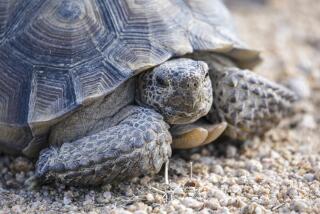Federal Officials Set Aside Worries Over Desert Tortoise, Rare Plant
- Share via
Reversing an earlier opinion, federal wildlife managers have concluded that expanding tank training at the Army’s Ft. Irwin in the Mojave Desert is not likely to jeopardize desert tortoises or the last remnants of a rare plant.
The U.S. Fish and Wildlife Service warned in 2001 that it would be almost impossible for the sprawling 643,000-acre base to expand by 118,000 acres without wiping out a population of endangered tortoises and patches of Lane Mountain milk vetch.
Fish and Wildlife biologist Ray Bransfield said Thursday that the agency’s new finding had been based on recent studies that had examined the possibility of moving tortoises from a site in Las Vegas to new environs.
In addition, he said, the Army had agreed to relocate about 1,300 adult tortoises in the expansion area so that they wouldn’t get “smushed by tanks.” It also plans to create milk vetch conservation areas outside the expansion area.
“The Army will be very happy.... This is one of the big approvals it’s been waiting for,” Bransfield said.
It may be two years before the expansion, which includes 75,000 acres of critical desert tortoise habitat, gets underway. Meanwhile, the Army aims to hold public hearings on the potential environmental effects of the expansion, a process that could take months.
“We can begin planning for the expansion,” said Ft. Irwin spokesman Capt. Dan Gannod. “But we still have a set of city and town hall meetings to go through, and we still have to prep the land.”
The tortoise recovery effort is expected to begin sometime next year. The Army has set aside $75 million for “buying land, fencing roads, translocating animals, then monitoring them,” Bransfield said. “If ravens or dogs start eating translocated tortoises, they’ll do something about the ravens and dogs.”
Details of the proposal to move the tortoises were still being worked out.
“We aren’t going to have a bunch of privates marching across the desert just picking up tortoises,” he said. “The plan is to send out a bunch of environmentally aware privates.”
In any case, the battle between tanks and tortoises in the desert near Barstow is far from over. Environmental groups are expected to mount a legal challenge against the expansion.
“Why did the Fish and Wildlife Service do an about-face on the expansion proposal? Because of the antienvironmental politics of the Bush administration,” said Daniel Patterson, desert ecologist for the Center for Biological Diversity.
Patterson also criticized the Fish and Wildlife Service’s most recent opinion on the proposed expansion. “You cannot kill and destroy critical habitat for wildlife,” he said, “without having all your mitigation details set in concrete at the time a federal biological opinion is issued.”
Mike Connor, executive director of the Desert Tortoise Preserve Committee in Riverside, said that he hadn’t seen the army’s report, but feared “it’s a disaster in the making.”
“This expansion proposal is a political decision that has nothing to do with the Army’s needs or the tortoises’ needs -- it’s been in the pipeline for years,” he said. “The desert tortoise is California’s state reptile for good reasons, and politicians need to think about them. It’s inoffensive, readily approachable and it has a lot of charisma -- people like them.”
The Fish and Wildlife Service considers the Mojave population of desert tortoises, which once numbered 300 per square mile, to be endangered. The Lane Mountain milk vetch, an herb that often grows inside low bushes, is also endangered.
The agency’s report is part of a lengthy process of study and consultation.
“I think it is a good day for the United States,” Gannod said. “We need more land to test our soldiers and their equipment in order to figure out where their limitations are.”
More to Read
Sign up for Essential California
The most important California stories and recommendations in your inbox every morning.
You may occasionally receive promotional content from the Los Angeles Times.














